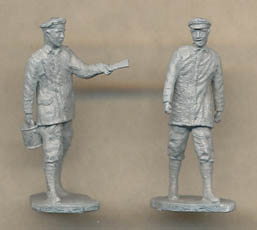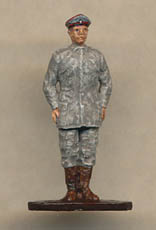The outbreak of war in 1914 came only a few short years after heavier-than-air flight had first been achieved, and the aircraft was still very much in its infancy. The war became a massive impetus for the development of this new technology, and all countries quickly saw the possibilities of air power, first for reconnaissance but soon as a weapon in its own right. In a largely anonymous war with vast armies and enormous casualties, pilots were turned into heroes, yet for each pilot there was a considerable number of people required to service their activities. By the end of the War the German air service had 80,000 personnel, but only about 5,000 of those were fliers, all of whom relied on the ground crew to keep the fight going. Pilots have been modelled before, but this is the first time that the ordinary ‘troopers’, the men that kept the machines in the air, have been modelled in our scale.
As usual these 3-D printed figures have been made in a semi-clear plastic which makes them look like ghosts in our photos and very hard to see the detail, so we have painted one pose and primed a couple of others to give a better idea of what these figures actually look like.


This is yet another very impressive set from this innovative company. The all-unique 30 poses cover a range of activities including on parade, but most must surely be engaged in looking after the aircraft in one capacity or another. Many have hands out as if manipulating something, perhaps servicing an engine or repairing some super-structure; basically this wide range of generic poses provides all the poses you could possibly want for such a diorama. Several have arms raised and outstretched, and are clearly pushing the aircraft or holding the wings down, while some could be about to turn the propeller and help get the aircraft started. The more casual walking poses are also very useful, but our eye was particularly drawn to the three poses carrying paint cans and clearly sprucing up the paintwork. However in a parade of great poses our favourite is the last man pictured, holding a tray with a bottle and three glasses. He may not be in combat, but it reminds us that in an incredibly filthy and uncomfortable war some airmen had a relatively civilised standard of living, at least when they were safely back at base.
The uniform of these men is simple and practical, as you would expect for mechanics with a dirty job to do. All wear standard fatigue dress of long tunic with skirt pockets over trousers. Some have long boots, others short ones, and many wear puttees which were introduced later in the war. All the ordinary ranks wear the classic German field cap or Feldmütse, widely worn throughout the army and with no peak. Senior NCOs and officers wore a peaked version, though there are hardly any of those here, and in any case junior ranks could add a soft peak to their cap from 1916 if they wished (at their own expense). So this is a set of the workers and not the officers (or the fliers), which is perfect, as are all aspects of the costume and appearance of these figures.
The sculpting is, as always, exceptional. The 3-D printing means there is no issues with solid moulds, so lots of great and natural poses can be achieved without undercuts, but that does not guarantee good sculpting, yet these are all of the highest quality, with great proportions and flawless detail (though these require relatively little detail anyway). Faces and hands are beautifully rendered, but it is the little human touches like the man walking along with his hands in his pockets that really shouts quality to us. No flash of course, and no assembly, so even the waiter/batman with the drinks is a single piece despite a very complex shape that would be quite impossible with a conventional plastic injection mould. Unfortunately no one has a base (we had to base the painted examples ourselves), and the clear hard plastic does mean they have to be painted to be properly seen, but that is a small price to pay in our view.
An extraordinary set which helps to highlight the possibilities of this still new technology, but also demonstrates such excellent design and attention to a natural appearance that is independent of the means of production. We cannot recommend this collection too highly, and for anyone looking to model a realistic Great War airfield this is not a set to be missed.